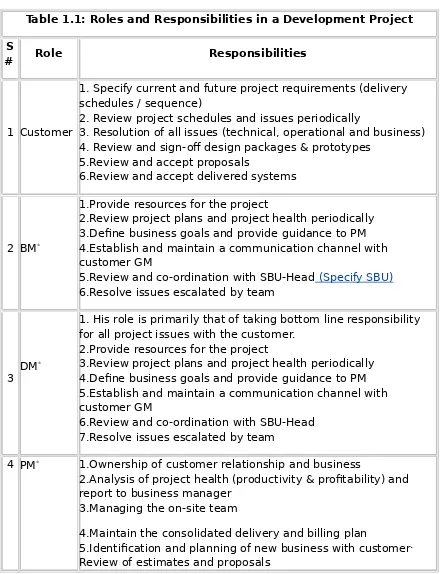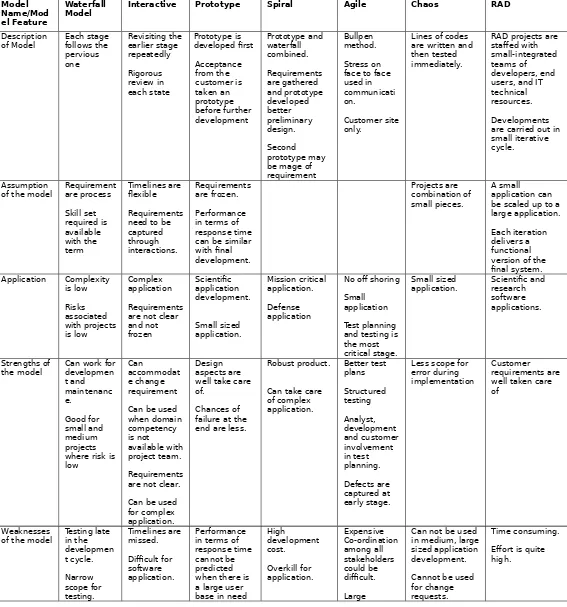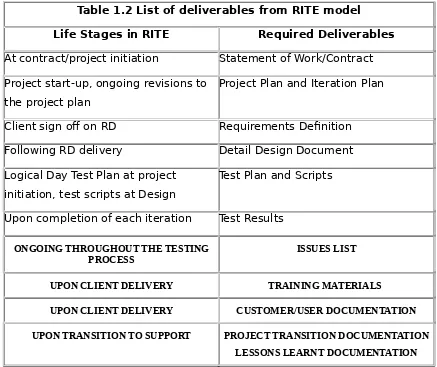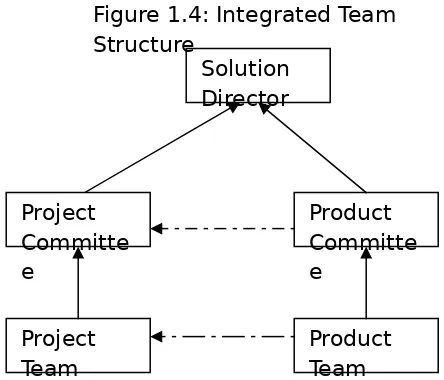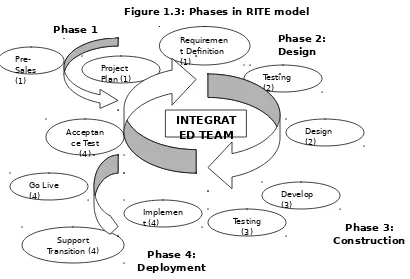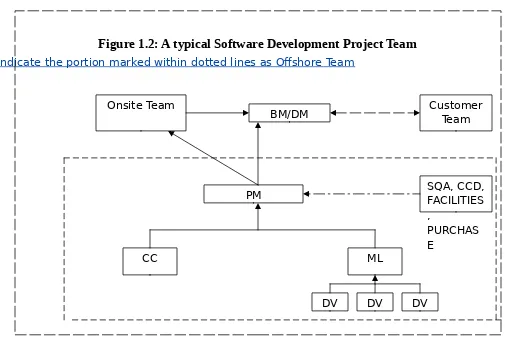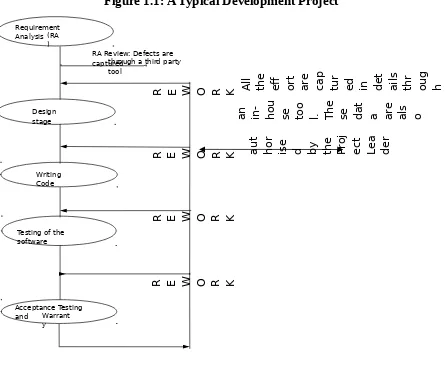CHAPTER ONE – SOFTWARE PROJECTS
LEARNING OBJECTIVES...2
UNDERSTANDING SOFTWARE PROJECTS...2
SOFTWARE PROJECT MANAGEMENT...4
SOFTWARE DEVELOPMENT CYCLE...5
SOFTWARE PROJECT ORGANIZATION STRUCTURE...7
TYPICAL SOFTWARE PROJECT ROLES AND RESPONSIBILITIES...8
CONSTITUENTS OF SOFTWARE PROJECT MANAGEMENT...9
SOFTWARE DEVELOPMENT MODELS – A REVIEW...10
Waterfall Model... 11
Iterative Model... 11
Agile Methodology... 11
Prototype Model... 12
Spiral Model... 12
Chaos Model... 12
Reliable Iterative Testing Environment (RITE) - software product development model... 13
Chapter One
Software Projects
Learning Objectives
At the end of the chapter, the students would learn:
Definition of software projects
Types of software projects
Definition of software products
Activities involved in project and products
Understanding software projects
A project in general, is understood to be a group of activities which are carried out to achieve a certain outcome. Each project, thus, will have objectives well defined, which would measure success or failure of the project. Construction of house, bridge, apartment complex, airport construction as well as renovation of existing airports are some examples of projects. Even making a movie, starting a new organization and revamping the exiting organization to achieve better results would also be considered as projects. In IT industry, software projects involve implementation of applications using new technology or improving upon the functionalities of existing applications using technology. The usage of technology for completion of application and using it for organization business purposes differentiates the software projects from general definition of projects. In essence, software projects uses technology to develop or improve existing applications for meeting business requirements. In software projects, the users will have general idea about how the application would look like and its applicability; where as in general projects, the output are usually a standard product and is known to many stakeholders. The software projects sometimes deal with abstract nature of end result and get modified as time elapses. Even after installation of the application, there could still be requests for changing the original requirement. In general projects such as construction projects, accommodating such changes after completion will be next to impossibility; but in software projects, the changes can be accommodated to suit the changing requirements.
Software projects should have certain activities and need to have minimum attributes for its successful completion. These attributes can be grouped under a framework which follows as shown below:
into a work order or purchase order or Letter of Intent. The written document then is presented to business group to get budget allocation or sponsorship. Depending on the merit of the idea and perceived business benefits to be accrued from such a project, the budget is allocated. The budget ensures that the business groups provide required resources – both finance as well as other resources – for successful completion of the defined projects. In this phase, different stakeholders are identified and their roles and responsibilities are clearly defined. The stakeholders then prepare an initial plan which will have details of milestones and expected final output, is prepared. A set of goals and objectives are also defined in this plan. The goals are usually broader in nature and will contain details of expected business benefits such as increase in productivity and reduction in cost of operations etc. The objectives will be precise and will contain details of delivery schedule with milestone, review points and expected quality of the application. These goals and objectives will drive the project team for execution of project in timely manner.
In order that the project team understands the goals and objectives well and works towards achieving them, the project management team should take care that these goals and objectives are well understood by them. Hence training sessions, kick off meetings are organized to help the team understand the purpose of the project. Deliverables are also defined so that the objectives can be met. Based on these objectives, testing strategy is defined which takes care of verification and validation approach for the project. The testing strategy should enumerate how the project team is going theto handle and meet different check points of deliverables.
T – Tasks or activities that need to be carried out; Hhere, based on objectives, tasks or activities are defined. These activities will be designed so that on completion of these activities, the desired objectives will be achieved. These tasks are well identified at the lowest granular level, resource allocated with expected completion of schedule and effort. During project monitoring, these detailed activities help the management to track the variance. Thus, tasks play a vital role in project control and monitoring activities.
V- Verification or validation process which is required to review and test intermediately the progress and quality of deliverables. This process is necessary to check quality of intermediate deliverables so that the final quality meets the objectives defined at the entry point. The process should be so defined that the quality is checked properly without being oan overburden on the execution. The activities in this process should follow and be aligned with testing strategy prepared at the entry stage.
deliverables are well defined in advance and project monitoring chart shows the readiness of the project.
M- Measurement; measurement refers to the system of measuring different parameters in project management. The metrics, as it is referred to, is defined by the measurement system and is aligned with goals and objectives of the project. Measurement system thus, includes metrics, data collection procedure, interval of data collection, person or role responsible for data collection, sample template for data collection. Metrics can be of two types – primary metrics and secondary metrics. Primary metrics talk about metrics derived from primary data such as effort, schedule, defect/issues etc. and secondary metrics is derived by using primary metrics such as productivity, cost of quality, effort variation, schedule variation and defect density etc. Secondary metrics is used to take managerial decision related to project management.
F- Feedback mechanism at periodic intervals as well as at the end of the completion of project is designed to give continuous feedback to the project management team. Feedback can be quantitative and qualitative as well. Quantitative feedback includes review comments, testing bugs etc. which are recorded and can be quantified. However, there will be qualitative feedback, where, look and feel of the application, usability etc. are given for further improvement.
In summary, a software project that is executed with this framework will have higher probability of being termed as a successful project. The criteria of successful project are defined at the entry stage. At the entry stage, objectives need to be well stated and should be made known to all stakeholders. The objectives should include timeline of delivery and a project will be considered successful if it can be delivered within the stipulated time frame. There are other criteria for considering a project as a successful. One of them is adherence to the allocated budget; a variance with respect to budget means cost over-run and will have cascading impact on related business decisions. With both schedule and budget being adhered to, quality of deliverables cannot be ignored. The project should be able to deliver an application that would be able to perform as per agreed specifications from the end users.
Software Project Management
planning should include the control and monitoring aspect of the project and should have details such as when to control, who should review the progress, what should be the quality of intermediary deliverables. Even escalation and communication protocol should be well defined in the planning document. Escalation policy should include different stages of escalation and typically is associated with service level agreement. If one particular issue is not closed within a certain time frame, then escalation policy should detail the next level of escalation with associated timeframe. Similarly communication protocol will have details of who to communicate with whom; this helps in offshore project development activities where there is a need to communicate with onsite team members and customers as well. The protocol guides the team members to categorize issues and to set up calls with corresponding colleagues.
The success of project management is entrusted to project manager. Even though there are many stakeholders, the project manager shoulders the responsibility of project manager successfully executing the project. To be successful, project manager goes through training and workshops to improve his skills. Some of the elements that contribute to the success of project management are – clearly stated and understood objectives, role and responsibilities of each team member, communication protocol, escalation process, clearly defined project organization structure which will show process of information flow, periodic status report review and change management process. These elements are translated into different processes and procedures such that the control and monitoring becomes quantitative and predictable. Predictability is an important aspect of project management; this ensures that customers as well as team members can predict quality, schedule of the deliverables. The predictability of project management is enhanced through usage of statistical tools and techniques such as Pareto chart, trend analysis etc. The project manager must be trained on these techniques.
Software Development Cycle
Software development cycle is used to break the entire application development into a number of processes phases. Small and manageable processes phases can be better controlled and monitored. These allow a methodical and systematic approach for development. Exact number of processes phases will be dependent on size of the projects and also varies from organization to organization. In the same organization, depending on skill of team members, maturity of processes, the development cycle can also vary. Sometimes processes phases are combined to make it shorter. Each of the phases will in turn consist of number of interrelated processes. In all the cases, a development cycle would at least consist of following processes phases –
the prospects and the likely area where there is a business need for developing a software application. The pre-sales team makes research in the domain as well as on the business need of the prospect, interacts with other researching organizations such as Gartner etc. to get valuable inputs related to their field of research. This information is then used to prepare a proposal to the prospect. Sometimes, looking at the need, the prospect may himself ask for a proposal from the vendor. This is known as ‘Request for Proposal’ and is usually sent to number of competing vendors. The proposal, in response to this RFP (Request for proposal) will contain estimation (ball park based rough estimation), quality processes adopted in the organizations to show predictability and quality of end deliverables from the vendor, financial proposals and past record of completing similar projects for other customers.
Requirement analysis- Requirements from the customers are gathered and analysed. A teamfew analysts from the software development team would meet the customer and would ask questions about the features and functionalities that are needed to be developed. These requirements are recorded and then reviewed again by the team along with the customer. A feasibility study is carried out to understand viability of developing these requirements into software applications. The findings of this feasibility study are discussed with customers. Once the customer signs off this document, this process is complete. At the end of this process, the customer should give go ahead for the application development and the project is kicked off. The formal document that is usually expected at the end of this process phase is a purchase order or work order or letter of intent or any such document indicating that the project execution has been awarded to the vendor. It is a good practice that the customer indicates details of quality of deliverables with acceptable limit for defects, delivery schedule expected and budget allocated for the project. This practice ensures that all the objectives of the project are mentioned tacitly and the project team can follow them during execution.
there could be more stakeholders such as legal department representative who would apprise the team about legal points related to particular project in question. Examples are legal points related to the country where the application is to be installed, statutory need for maintaining data and back up for transactions etc.
Design- This stage is the next step after requirement analysis stage. The entry criteria for this stage is the signed off requirement document from the customer. The activities in this stage are converting the functional requirements stated in the requirement document to design specifications. These specifications are arrived at by looking into hardware and software constraints; e.g., if PCs with lower memory are to be used, then design needs to take care of performance related issues. Here the design will be made such that processing time for the CPU will be reduced. This will ensure that final output from the application is available within performance criteria mentioned in the requirement document.
Point to be noted that during the design stage the design team usually breaks the entire requirements to manageable small modules. These modules can be developed in parallel so as to reduce the development cycle. The idea of breaking into small modules is to make manageable, independent modules which can be developed in parallel, thus, saving time. (It will be nice to add few points on designing the technical architecture for the solution involving the selection of technologies for the project. Many a times, technology selection is already done by the client it also becomes a constraint) and rarely it is left upto the project management team to suggest suitable technologies.)
Construction- Based on the functional design specifications, the development team writes code, does unit self testing, and then integrates all modules. Here the team needs to take care that all specifications mentioned in the design documents are met. Periodic reviews are carried out to ensure that code complies with defined coding standard and also meets design specifications.
Testing- The team prepares a testing strategy. The strategy shows the type of testing that needs to be done, the stage when testing needs to be carried out and the participants in that testing. It also explains the criteria as to when testing should be stopped. A test plan is also prepared which will indicate all test cases and the expected results from this testing. While testing, proper environment set up (which includes test data set up, creation of ids for testing, if required) is also done so that a proper simulated condition is created.
application on the customer machines. The team also supports the customer and application after acceptance testing. The period of this support/warranty will be dependent on the contract signed with the customer at the beginning of the project. After successfully testing the application, and migrating data to the new database, if required, the application ‘goes live’. ‘Go live’ implies the application is ready to be used in the production and can be used for business transactions. It also means that all the required end users are trained and well versed with the new application and can use them on regular basis.
Maintenance- This process starts after application is installed and goes to production and the warranty period is over. The project team enters into an agreement with customer to fix bugs and issues coming out of production (maintenance), enhance existing features and add new features as well. The maintenance is usually carried out by contract.
Software Project Organization Structure
In order to get effective communication between different stakeholders in software projects, a formalized project organization structure should be defined. For a typical project organization structure, please refer to figure no. 1.2 for a pictorial representation of organization structure. A project organization structure has different components and roles. The structure is designed for easy flow of communication among project and customer team. The solid lines represent direct reporting where as dotted line shows administrative responsibilities.
Business Manager (BM) or Delivery Manager (DM) is the head in the structure who have the bottom-line responsibility to execute the project. Project Manager (PM) reports on the delivery status to the BM/DM on a periodic basis. This periodicity can be decided to be weekly or monthly basis depending on the complexity and criticality of the application.
PM is supported by Module Leaders (ML) who take care of individual modules. The MLs are typically technical leads who are expert in both technology as well as in domain knowledge. They help developers (DV) who write the design and code documents. In the project team, CC (Configuration Controller) takes care of giving proper access to different groups. For example, PM will have read/write access in all the folders where as developers will have write access in their work area only. These are taken care by CC.
Typical software project roles and responsibilities
In order that the above organization structure is effective, responsibilities of each role needs to be defined. Given below in table 1.1 is an illustrative role and responsibility matrix.
Table 1.1: Roles and Responsibilities in a Development Project
S
# Role Responsibilities
1 Customer
1. Specify current and future project requirements (delivery schedules / sequence)
2. Review project schedules and issues periodically
3. Resolution of all issues (technical, operational and business) 4. Review and sign-off design packages & prototypes
5.Review and accept proposals
6.Review and accept delivered systems
2 BM
1.Provide resources for the project
2.Review project plans and project health periodically 3.Define business goals and provide guidance to PM 4.Establish and maintain a communication channel with customer GM
5.Review and co-ordination with SBU-Head (Specify SBU) 6.Resolve issues escalated by team
3 DM
1. His role is primarily that of taking bottom line responsibility for all project issues with the customer.
2.Provide resources for the project
3.Review project plans and project health periodically 4.Define business goals and provide guidance to PM 5.Establish and maintain a communication channel with customer GM
6.Review and co-ordination with SBU-Head 7.Resolve issues escalated by team
4 PM 1.Ownership of customer relationship and business
2.Analysis of project health (productivity & profitability) and report to business manager
3.Managing the on-site team
4.Maintain the consolidated delivery and billing plan
6.Provide manpower requirements
7.Maintain the project management plan
5 ML
1. Allocates work to DVs in consultation with PM
2. Tracking and Monitoring progress of DVs for allocated work
3. Manage the delivery plan for his team
3. Resolve Technical issues with onsite coordinator and customer
6 DV
1.Develop detailed design 2.Develop test plan
3.Coding of program 4.Self Testing
5.Code Reviews 6.Unit testing
7.integration testing
8.Communicate with on-site contact
7 CC
1.Develop / Maintain configuration management plan 2.Implement configuration management plan
3.Conduct configuration audits
4.Publish results to PL and MLs and create an entry in RADAR 5.Provide assistance to ML/team in implementing configuration standards
8 SQA
1.Review implementation of quality processes in modules 2.Review implementation of project plans
3.Review Metrics and analyze against quality targets
4.Assist PL/MLs in implementing project plan and processes 5.Co-ordinate internal and external audits
6. Follow up closure of NCRs and observations 7.Escalate issues to BM, whenever necessary
Constituents of software project management
All projects have different constituents that behave differently under different conditions and hence are unpredictable. As a result, it becomes difficult to exercise control over them. At the start of the project, these constituents not fully known and hence add to the woes of project management. For example, initial requirement analysis and gathering would have detailed out the needs of the end users. However, as the project progresses, a lot of changes happen to these requirements. The business model of the customer might change resulting in change in requirements; change of end users i.e. a separate set of end users would definitely like to change the requirements of their predecessors thus, making it difficult to proceed in project execution as it was planned earlier. These changes have cascading effect on the next processes phases such as design, construction testing etc. Whatever would have been planned based on initial requirement analysis would have to be changed to accommodate the new changes. As a result, initial estimation for effort, schedule and objectives have to be revisited which result in cost overrun. Many times these changes lead to customer dissatisfaction and new elements of behavioural aspects come into play.
For project management, control and monitoring of the projects are quite important. To manage this, the project is usually broken into smaller manageable granular level of work. These granular work help in tracking these work to completion. It has been observed that no two projects will have similar granular level details as the projects will differ from each other in terms of their objective. As a result one project structure will not be effective for another project. This is evident from the fact that in smaller projects, high level design and lower level design can be combined to make one design stage; whereas in larger projects, these can be separate so that databases can be effectively designed and used. In smaller projects there could be one testing stage which will be combination of integration testing and system testing; where as in larger projects there could be more than on system testing stage. An effective project management must ensure that all these stages are well defined and at the completion of the stage, the deliverables are reviewed, corrected or modified and rework completed. It is advisable to have a formal sign off so that the team can move to the next process.
project management can be tailored to reduce any unnecessary bureaucratic procedures.
It can be summarised to say that project management process has following constituents that need to be understood well for better control and monitoring. These are Estimation, Monitoring and control, Defect management, Change management, Risk management, Verification and validation process, Project organization structure. Detailed discussion on these constituents will be done in chapter 2.
Software Development models – a review
Software Engineering projects follow different lifecycle models. These models are waterfall model, iterative model, spiral model, agile software development model, Prototype model, Chaos Model, and Rapid Action Development model. These models can be used for developing software products.
Waterfall Model
Royce (1970) proposed waterfall model in which software development follows a sequential order of life cycle stages. These life cycle stages are: requirement specification, design, construction, integration, testing, installation and maintenance. However, this model is flawed as in the real world of software development, there is a need for flexibility to accommodate any change in requirement and thus in following the stages sequentially such accommodation may not be possible.
Iterative Model
Agile Methodology
Aydin (2005), Abraham (2003), Scrum (1986), and Curt Sampson have proposed agile methodology as a model for software development. In this method the entire project team necessary for completing the project including customers is located in bullpen and face to face communication is encouraged for discussion instead of depending on written documents. The bullpen1 also includes testers, designers, managers and technical writers. This method involves preference for face-to-face communication, and very little written documentation relative to other methods. Therefore the method is criticized as lacking discipline. Also this model is difficult to use in large projects and cannot be used where offshore development is preferred to take advantage of highly skilled and low cost professionals. One of the well known agile methodologies is Extreme Programming (XP) (Kent Blanc, Ward Cunningham and Jeffries Ron, 1996 and McBreen, P 2003); in which software is developed in small packets and lot of importance is given to testing and writing test cases even before coding. This method has a lacuna that it can be used only at customer site and for small applications and it cannot be off shored.
Prototype Model
In Prototype model (Haag, S, et al.,2006); a prototype or working model is developed first to check design and feature aspects of the application to be developed and to get user feedback so that risk and cost associated with the final application is reduced. Prototyping is part of design process and after incorporating feedback the product is ready for production. However, performance related to stability and reliability of the final production cannot be tested in prototype as prototype may not be scalable at all times. This again can be used for small to medium size applications and is not feasible with large production requirement.
Spiral Model
Spiral Model (Boehm, 1988; Belz, 1986 and Livary, 1987) combines prototype and waterfall model. This model is favoured for large projects. In Spiral model,
requirements are gathered in details and a prototype is developed after preliminary design. Feedback is obtained from customers on this prototype and if required a second prototype is developed which is an improved version of the first prototype. In this approach, risk factors would include development cost overruns, operating cost miscalculation, or any other factor that could, in the customer's judgment, result in a less-than-satisfactory final product. Hence this is used for mission critical applications (for defence applications) and will be overkill for software development.
Chaos Model
There are also other development models such as Chaos model (Raccoon, 1995), and Rapid action development (RAD) model (McConnell, 1996; and James,1980). In Chaos model, projects can be thought of in pieces. Nobody writes tens of thousands of lines of code in one sitting. They write small pieces, one line at a time, verifying that the small pieces work. Then they build up from there. The behaviour of a complex system emerges from the combined behaviour of the smaller building blocks. RAD projects are typically staffed with small integrated teams comprised of developers, end users, and IT technical resources which are combined with short, iterative development cycles optimizes speed, unity of vision and purpose, effective informal communication and simple project management. An important, fundamental principle of RAD is that each iteration delivers a functional version of the final system. These models are used for developing applications where requirements are fairly stable and the size of the application is small. Also handling complex applications and change requests during development life cycle becomes difficult in both these models.
A comparative analysis of these models is given in table 1.1
Reliable Iterative Testing Environment (RITE) - software
product development model
RITE model against other software development models lays emphasis on iterative testing. This means that packets2 are tested even during requirement phase. As the
the project progresses in its life cycle phase the testing of packets continues till the products are delivered to the customer. Using this methodology, products are developed in “packets”. After building these packets, not only each packet is tested thoroughly, but also these are integrated and testing is carried out for each new product. The entire product is developed and delivered through an “integrated team” approach. The methodology has four phases. In phase 1, contract is signed with the customer, and based on contract an integrated team is developed. Contract is quite significant in RITE model as the entire scope is determined at this stage. Even though change requests are accommodated later on, this helps 3IS(???) to track extra effort required to develop these change requests. This also helps in billing accurately to the customer. After contract is signed and purchase order is received, requirement gathering and analysis of requirements is carried out. In phase 2, detailed design specifications and test scripts are written based on requirement analysis. Phase 3 primarily takes care of packets development and testing. And finally installation, user training, user acceptance testing and transition to support happen in phase 4. Each of these phases is described here and a schematic diagram is given in figure 1.3.
The RITE methodology framework also addresses how a project team is put together to deliver a product. This concept is called the Integrated Project Team Approach. The Integrated Team consists of Project Committee, Product Committee, Product team (all these are based at onsite, near the customer) and Project team based at offshore location. Project committee works with marketing team in pre sales activities; it helps the marketing tem to clarify any doubts that a prospect will raise during the initial discussion period. Once a prospect is turned into customer, it is the responsibility of product committee to provide a detailed estimation, negotiate with the customer and then enter into a detailed contract. The contract, apart from other things, will highlight scope, timeline of delivery and the total effort that would be spent while executing the project. The offshore project team reports to this committee. The project committee reports to solution director who is overall responsible for providing the products to customer.
The product committee largely consists of domain experts, who based on market research, interaction with customers and industry experts, would design different ‘packets’. The packets, as explained earlier, will be independent to each other and would be integrated by offshore project team. These integrated packets would be delivered to the customer. The product committee would also define what is known as road map for each product. The road map for products consists of timeline for developing different features. These features would be part of the packets and would be developed by the product team. The product team directly reports to this product committee. Both product committee and product teams are based at onsite.
Project offshore team has a primary responsibility of integrating packets, iterative testing and delivering the final integrated products to the customers. The team has expertise in testing and integration of packets. A schematic organization structure is shown in Figure 1.4.
Each life cycle stage in RITE model has defined deliverables. These deliverables ensure that proper and effective documentation is carried out without making these activities as overhead. Quality System Documentation, an internal system that details all the procedures and processes, is used as reference while developing software using RITE model. QSD is internal to organization and is used as induction training material to new entrants at all levels. This ensures that employees at all levels are familiar with deliverables expected out of them. Table 1.2 lists key deliverables in RITE model.
Summary
Case Study
Mahindras have a good reputation as IT service provider. They are known for their ability to understand the needs of their customers and develop software applications accordingly. They have successfully executed a number of projects at offshore locations (India) and have current strength of 5,000 employees. Their domain knowledge has been developed over the years by working in different domains such as Retail, Utilities, Supply Chain Management, Insurance sectors.
Recently they want to enter into Telecommunications domain. After making a number of attempts, they got a project in telecommunications (telecomm, in short) domain in Australia. This was a major breakthrough for the company as not only they entered telecomm domain, they also made a foray into a new geography – Australia. They wanted to put together a new team and selected Gopinath as the project manager. Gopinath had extensively worked in Retail and Supply chain domain and had handled more than 10 large projects in his 7 years career with the company. He had a good knowledge in COBOL and was considered as a good technical reviewer of code written in COBOL. He also had good understanding of customers in US, where all of his projects had been implemented.
Quality processes in Mahindras were matured and have stabilized over the years. However, these proceses are related to domains other than that of telecomm; also it is well known that relationship with customers in US will require an approach different than that of customers in Australia. This meant communication protocol will require a different approach. Regulatory conditions in US are also different than that of Australia and these needs to be well understood by the team. Travelling to Australia was easier as there was no need to plan for H1B visas (like that of US) well in advance.
Questions:
1. How should Gopinath go about executing this project?
2. What are the constituents of project management that need to be stressed?
3. What kind of development model to be followed for this project and why?
Discussion Points
1. What do you mean by a software project?
3. What are the roles of a project manager?
4. Explain different constituents of project management in IT industry.
5. What are differences between a software project development cycle and a software product development cycle?
References
Abrahamsson, P., Salo, O., Ronkainen, J., & Warsta, J. (2002). Agile Software Development Methods: Review and Analysis. VTT Publications 478.
Abrahamsson, P., Warsta, J., Siponen, M.T., & Ronkainen, J. (2003). New Directions on Agile Methods: A Comparative Analysis. Proceedings of ICSE'03, 244-254.
Barry Boehm, (1970), “Build it twice”, Proceedings ICSE9.
Barry Boehm,1986, A Spiral Model of Software Development and Enhancement, ACM SIGSOFT Software Engineering Notes (SEN), August 1986
Barry W. Boehm, 1996, Anchoring the Software Process IEEE Software, July 1996, pp.73-82.
Boehm, B, 1988,A Spiral Model Of Software Development And Enhancement IEEE Computer.
Boehm, B., 1981, Software Engineering Economics Prentice-Hall. ISBN 0-13-822122-7 (pages 41-2, 254).
Boehm, B., 1985, A Spiral Model Of Software Development And Enhancement, 2nd. International Software Process Workshop. Coto de Caza, Trabuco Canyon, USA 1985.
Boehm, B.; R. Turner (2004). Balancing Agility and Discipline: A Guide for the Perplexed. Boston, MA: Addison-Wesley. ISBN 0-321-18612-5. Appendix A, pages 165-194
Bohem B.W., and Belz F.C., “Applying Process Programming to the Spiral Model,” Proceedings Fourth Software Process Workshop, IEEE, May 1988.
Cohen, D., Lindvall, M., & Costa, P. (2004). An introduction to agile methods. In Advances in Computers (pp. 1-66). New York: Elsevier Science.
Larman, Craig and Basili, Victor R. Iterative and Incremental Development:A Brief History IEEE Computer, June 2003
Larman, Craig; Victor R. Basili (June 2003). "Iterative and Incremental Development: A Brief History" (pdf). Computer 36 (No. 6): pp 47-56.
DOI:10.1109/MC.2003.1204375.
Livary, J., “ A Hierarchical Spiral Model for the Software Process,” Acm Software Engineering Notes, Jan 1987, pp. 35-37.
Raccoon (1995) The Chaos Model and the Chaos Life Cycle, in ACM Software
Engineering Notes, Volume 20, Number 1, Pages 55 to 66, January 1995, ACM Press.
Royce, Winston (1970), "Managing the Development of Large Software Systems", Proceedings of IEEE WESCON 26(August): 1-9.
Glossary
Project management
Software project management
Verification
Validation
Metrics
Requirement Analysis
Design
Table 1.1: Comparison of different software models
Model Name/Mod el Feature
Waterfall
Model Interactive Prototype Spiral Agile Chaos RAD
Description
of Model Each stage follows the pervious
of the model Requirementare process
Skill set
application. Scientific and research software applications.
Strengths of
Minimal test planning.
Deadlines to take priority of over quality.
time.
May not be scalable all the time.
Cannot be used for large application.
Cannot accommodate change requests after prototype is built.
application development is not easy.
Table 1.2 List of deliverables from RITE model
Life Stages in RITE Required Deliverables
At contract/project initiation Statement of Work/Contract
Project start-up, ongoing revisions to the project plan
Project Plan and Iteration Plan
Client sign off on RD Requirements Definition
Following RD delivery Detail Design Document
Logical Day Test Plan at project initiation, test scripts at Design
Test Plan and Scripts
Upon completion of each iteration Test Results
ONGOING THROUGHOUT THE TESTING
PROCESS ISSUES LIST
UPON CLIENT DELIVERY TRAINING MATERIALS
UPON CLIENT DELIVERY CUSTOMER/USER DOCUMENTATION UPON TRANSITION TO SUPPORT PROJECT TRANSITION DOCUMENTATION
Solution Director
Project Committe e
Product Committe e
Project Team
Pre-Sales (1)
Requiremen t Definition (1)
Project
Plan (1) Testing
(2)
Design (2)
Develop (3) Implemen
t (4) Acceptan
ce Test (4)
Go Live (4)
Support Transition (4)
Testing (3)
Phase 1
Phase 2: Design
Phase 3: Construction Phase 4:
Deployment
Figure 1.3: Phases in RITE model
Indicate the portion marked within dotted lines as Offshore Team
Onsite Team
BM/DM Customer Team
PM SQA, CCD, FACILITIES
,
PURCHAS E
CC ML
DV DV DV
Requirement Analysis (RA
)
Figure 1.1: A Typical Development Project
Design stage
RA Review: Defects are capturedthrough a third party
tool
Writing Code
Testing of the software
Acceptance Testing and Warrant
y
A
ll
th
e
e
ff ort are cap tur ed in det ails thr oug h
a
n in- hou se too l. ehT se dat a are als o
a
u
t
h
o
r
is
e
d by the Pro
j
e
ct Lea der
R E W O R K
R E W O R K
R E W O R K
